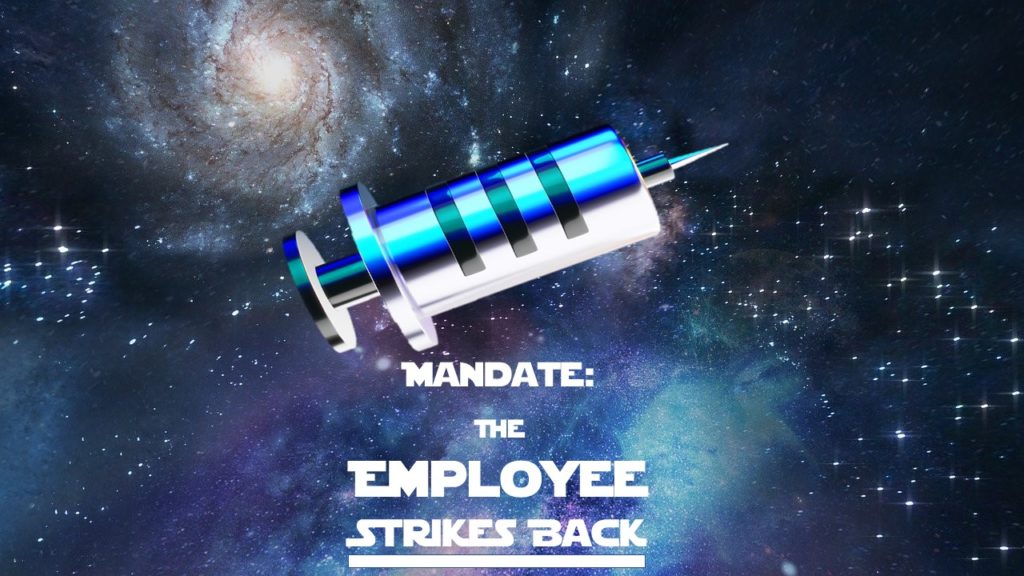
The Pandemic Saga Continues
It may not be the Rebel Alliance organizing the opposition, but the announced Vaccine Mandate by President Biden on September 9th has excited the views and opinions of the American workforce. Within days, we can expect to see the language of OSHA’s Emergency Temporary Standard (ETS). What have you done to prepare your organization for one of the most contentious subjects in American employment history? Here are seven critical considerations to review with your leadership before enforcement begins.
Do you know?
What will be the impact of implementing a vaccine mandate in your workplace? Studies have indicated that anywhere from 2 – 8% of any given employer’s workforce will resign. In some industries that number may be higher. Do you fully understand the risks to your organization if you were to lose essential skill sets? Do you have a strategy ready to deploy that will replace those key resources? Do your customers and stakeholders understand what that impact will mean to them? Can your brand sustain major disruptions?
Vaccines or Testing?
In the absence of the yet-to-be-released ETS, we don’t know what type of testing will be permissible or who will be responsible for its payment. Organizations recognizing the threat to their ongoing operations if they were to lose significant skilled staff and productivity have offered testing as an alternative to receiving the vaccine and are going to pay for it. Even though President Biden’s comments included his desire to lower the cost of testing, this option could become cost-prohibitive for many except for the largest organizations. Is testing an option you are considering along with its costs and associated logistics (when, where, compensation for testing, collecting, storing results, etc.)?

Who talks with whom?
Sharing personal medical information is a sensitive subject especially if it involves doing so with someone you work with. Individuals have become well versed in HIPAA and ADA highlights and many are reluctant to share information they may believe can be used in making employment decisions. It is generally lawful for the employer to request vaccination status as determined by the EEOC. Supervisors should not be put in a position of gathering vaccine status or testing information. Designate a specific person or a limited number of individuals on your HR team if you have one, or an individual that can be looked to as a trusted resource to gather and maintain confidential information. Potential legal risks abound in this process so employees must be clearly informed to provide vaccination status only and no other medical history or personal health information. To further avoid legal confidentiality risks, create and maintain a confidential list of vaccinated employees once proof is provided rather than retain copies of the valid vaccination records. Collecting and storing vaccination records requires all the strict legal requirements of medical confidentiality and the OSHA requirement of retention during the employment of the individual plus 30 years.
Who gets it?
We discussed the option of weekly testing vs. proof of vaccination above, but what about medical or religious exemptions and accommodations? Though encouraging vaccinations, some organizations have indicated they will consider religious or medical exemptions. Others have indicated that such exemptions will be extremely rare. How are you going to address requests for religious or medical accommodations? You must structure a clear and reasonable policy for addressing religious and disability concerns when presented with a request for an exemption to being vaccinated. Even though each request must be addressed in a confidential and thoughtful manner, demonstrating a consistent approach for all requests is critical. It is reported that one employer has informed their employees that they will use their medical claims history with each request for religious accommodation to determine whether previous medical care is consistent with their current stated belief. Determining the validity of the objection and engaging in the interactive process to determine accommodations is still a requirement. Review with your legal counsel to prepare an individual or individuals to manage this process.
“Am I listed among the 100?”
The Department of Labor has indicated that the 100-employee count will be a company-wide tally. “What if I work remotely?’ The Department of Labor has indicated that remote workers not expected to report to the defined workspace, will not be covered by the ETS. What happens if you expect those remote workers to periodically report to the office or defined workspace? It appears you will need to include them in the mandate for either vaccination or testing.
What about OSHA?
Under the Biden administration, OSHA has been asked to increase its ability to enforce regulations and if the ETS is released, every employer should consider how they will respond to a knock on the door from OSHA. A large percentage of employers have probably never been subject to an OSHA inspection. Are you preparing your leaders and employees how to respond to an OSHA visit? Do you have policies and directives for addressing the OSHA Guidance on Mitigating and Preventing the Spread of COVID-19 in the Workplace, originally posted in January of this year? Is your workplace subject to local or state orders? Do you have a COVID-19 response plan? Can you present training records for all your employees on all these topics? OSHA can cite you for up to $14,000 for each violation, so take the time to get all this in order.

Mine Safety & Health Administration (MSHA) regulated operations will not be subject to the ETS however, some MSHA regulated facilities also have OSHA regulated operations onsite. How will you address the requirements of those employees vs. those working in your MSHA operations and how will that affect employee and labor relations.
Have a Union?
If you have a unionized workforce, do you have a duty to bargain over the implementation of the ETS? This is a question you will need to discuss with your labor counsel as it appears implementation of the ETS and its impact on collective bargaining agreements does not appear to differ from the implementation of other OSHA standards. Depending on your labor agreement, you may at a minimum have an obligation to bargain over the effects of the decision to implement the ETS. For non-union employers, the implementation of the ETS could become a focus in organizing efforts.
What’s next?
Will the ETS hold up to the many legal challenges it is expected to face? Recognizing that the ETS will take immediate effect in the 29 states covered under federal OSHA once it is published. What will happen with the 21 states who are OSHA-state-plan states? Will certain states opt for more stringent standards than the ETS? No employer should be taking a “wait and see” approach. There is a great deal of work involved to meet all the requirements we know will be involved and surely there will be many more in the ETS. If you need help getting ready for what lies ahead, contact me at: kmoulton@anewoutlookgroup.com.

Great information as always.